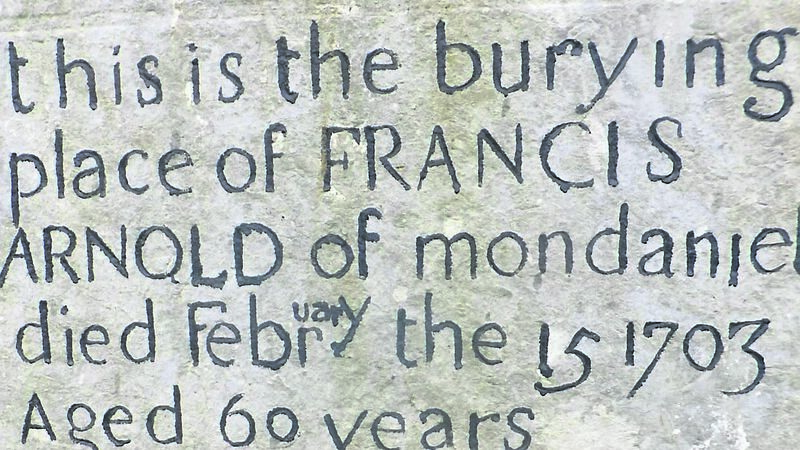I read old headstones by moon light, ghosts don’t scare me...

For centuries - nay for nearly 2,000 years - people, especially Christians, blessed themselves, saying the words ‘In the name of the Father, the Son and the Holy Ghost’.
As one made the sign of the Cross, the phrase was uttered in reverence. As Eamonn Kelly used to say, ‘Things rested so’, and so they did until one of the Popes in the 1960s or 70’s had a ‘lightbulb’ moment in the Vatican.
All was changed, utterly changed, and without as much as a bellow from any Papal Bull, the Holy Ghost got his P45 and was soon replaced by the seemingly more politically correct ‘holy spirit’.
I have asked theologians and would-be philosophers ‘what’s the difference between a ghost and a spirit’? Even the most learned scholars are flummoxed by that question. They argue the toss that there’s little difference really.
Grand so, says I - so why change something for the sake of change so, if there is no sound or valid reason for such a move?
Leave me alone about ghosts and spirits. We are slap bang in the middle of November - the Month of the Holy Souls - and if anyone can rationally explain to me what’s the difference between a soul and a spirit - or a ghost for that matter - I’ll put them forward for a Nobel Prize for Understanding.
Maybe the Pope in Rome that made the change thought the term ghost was a bit frightening because it’s associated with ghouls, goblins and ghost stories - usually not a bag of laughs.
I think it’s my duty as a believer to stand up for ghosts and get them reintegrated into society, both secular and otherwise.
November 1 is All Saints Day when the millions of ‘uncanonised’, unknown or unremembered people who lived good and saintly lives are remembered. Personally, for me, I always try and go to Thurles on that date each year - GAA Day I call it - the date when the Gaelic Athletic Association was founded in Miss Hayes’ Hotel in 1884.
In this time of tourism promotion, I think Thurles should be in festive, even festival mood each year on this special day. But sure, what do I know about promoting commerce or getting visitors to spend in the town near Slievenamon?
Anyway, I went to the cathedral where Archbishop Croke is buried - a Saint if there ever was one. I lit a candle for him and stood in silence at the Croke memorial in the Square.
It was just after midday when I was at Semple Stadium. No signs for ‘Meat Teas’ or ‘Plain Teas’, or no hucksters shouting ‘Hats , Caps or Scarves’ or ‘Ripe Bananas’.
As I crossed the Bridge, the road was empty, yet in my mind’s ear I could hear the tunes being played by the Dunne brothers and the jingle of pennies, thrupenny bits, tanners and shillings being thrown in the cap on the ground.
Don’t let anyone tell me the ghosts (call ’em spirits if you don’t want to frighten the children) of Ring, Mackey, Doyle, Keane, Smyth and hosts of other great hurlers aren’t around there - of course they are.
We are told that the basic tenet of Christianity is the fact that after human death the soul leaves the body. Well, I for one have no problem with that concept. The human body has frailties and physical limitations but the soul has none - a true free spirit so it comes and goes without restraint or constraint.
The ghosts or souls of spirits of hurlers are bound to have a heavenly reverse gravitational ‘pull’ back to scenes of great old battles and games.
I recall many years ago a neighbour of ours, Mrs Scanlan, telling Donncha Ó Dúlaing on RTÉ’s 301 programme about the sounds she heard on Melaheen Moor when she was young -about 100 years ago. She mentioned the ‘whish’ you’d hear most summer evenings - fine, calm, warm evenings, - and she had no doubt it was the little people or fairies as they played games of hurling, and the ‘whish’ was the sliotar as it was pucked from one to another.
Over a decade ago, I was researching a book on the inscriptions on the headstones in Gortroe Cemetery near us. Many of the stones were erected in the 1800s. Some were covered with ivy, others leaning backward and forwards, and more covered in moss and lichens.
Even after carefully and gently cleaning them, the lettering was still hard to decipher. Using any kind of chemical cleaner was out of the question. Chemical products will certainly clean limestone headstones, but the problem is if any acid-based cleansing agent is used, it can get into the pores and veins of the stone and, over time, literally ‘eats away’ the stone.
I was told that if you examine the ancient headstones on a bright, moonlit night it’s simple to read the inscriptions. And so it was many the moonlit hour I spent amongst those memorials to the long since deceased.
When I told friends of my nocturnal pilgrimages, many shuddered and asked, ‘Wouldn’t you be afraid of ghosts?’ Why should I, shure everyone in that cemetery - well, most of them anyway, didn’t I know of their seed, breed and generation?
‘No’, says I, ‘I’ve no fear of anyone in the graveyard, but it’s outsiders coming in the gate that I’d be wary of!’
This November, I’ll visit a fair share of cemeteries, burial grounds and graveyards to say a few Aves for those I know and also for those who have no-one to whisper even the shortest prayer for them.
Does saying prayers in a cemetery better the ‘chances’ of people getting to heaven if they’re not already there? I can’t answer that, but this much I know, a prayer or two never did harm to anyone.
Cemeteries are like books - full of stories, some finished and some waiting for more chapters to be added in years or decades to come.
I was at the funeral of a friend and relation in Dunbullogue during the week. He was great storyteller. When his own father died 50 or 60 years ago he was buried in the same cemetery, in the ‘old ground’. All graves were dug by hand back then and the family of the deceased usually supplied refreshments of the solid and liquid types to the gravediggers during their work.
Well, on the morning of the burial the four men doing the job were working away grand until the man we buried this week produced a bottle of whiskey for the boys. They had a sup and dug a little more. Then a bigger sup and they dug a bit less -and so it went on.
They tried to manipulate the coffin over and back, up and down, but the inebriated diggers had ‘finished out’ the grave about six inches too narrow. The shovels had to be reintroduced, sober men got to work to make the required adjustments.
Eventually, the burial was completed. Where there’s will there’s a way and where there’s a headstone there’s a story. This November may they all rest in peace, in the name of the Father and the Son and the Holy Ghost, Amen.







 App?
App?




